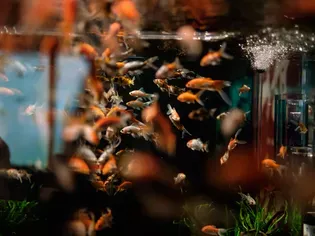Breeding Aquarium Fish, Basic Breeding Tips For Beginners
Updated on 04/26/24

Unlock the Secrets of Aquarium Fish Breeding: A Comprehensive Guide for Beginners
Introduction
Embark on an enthralling journey into the world of aquarium fish breeding, a captivating hobby that offers endless rewards. This definitive guide will equip you with the fundamental knowledge and practical techniques to successfully breed your beloved aquatic companions. Whether you're a seasoned hobbyist or just starting out, this comprehensive resource will guide you through every aspect of fish breeding, empowering you to create vibrant and thriving underwater ecosystems.
Laying the Foundation: Selecting Suitable Species
The first step in successful fish breeding is selecting species that are compatible and have specific breeding requirements. Consider the following factors:
* Compatibility: Choose species that coexist peacefully and do not prey on each other.
* Breeding Habits: Research the specific breeding habits of your chosen species, such as egg-laying, live-bearing, or colony-spawning.
* Water Parameters: Ensure that your aquarium water meets the optimal parameters for the species you intend to breed.
* Experience Level: As a beginner, it's advisable to start with species that are relatively easy to breed, such as guppies, swordtails, or tetras.
Creating the Ideal Breeding Environment
To promote successful breeding, it's crucial to create a conducive environment within your aquarium.
* Separate Breeding Tank: Establish a separate tank dedicated solely to breeding, free from the distractions and potential aggression of other fish.
* Optimal Water Quality: Maintain pristine water conditions with stable pH, temperature, and low nitrate levels. Utilize filtration and water changes to ensure water quality.
* Proper Hiding Places: Provide ample hiding places for both adult fish and fry (baby fish) to reduce stress and ensure protection.
* Specialized Lighting: Adjust the lighting cycle to mimic the natural breeding season of your chosen species.
Encouraging Spawning: Triggering the Breeding Impulse
Creating the right conditions can trigger the breeding impulse in your fish.
* Water Temperature: Slight fluctuations in water temperature can stimulate spawning behavior in some species.
* Spawning Substrates: Introduce spawning substrates such as gravel, plants, or spawning mops to provide a suitable surface for egg deposition.
* Live Food: Offer nutritious live food to encourage egg production and improve fry development.
* Courtship Display: Observe the courtship display of your fish, which can involve chasing, circling, or fin flaring.
* Sex Ratio: Maintain an appropriate sex ratio within your breeding tank to increase the chances of successful mating.
Egg-Laying Species: Nurturing and Hatching
If you're breeding egg-laying species, follow these essential steps:
* Removal of Parents: After spawning, remove the adult fish from the breeding tank to prevent them from consuming the eggs.
* Egg Incubation: Keep the eggs in a separate tank or incubator with stable water conditions and gentle aeration.
* Hatching Process: Monitor the eggs closely and provide proper care until they hatch, which can take several days to weeks.
* Fry Care: Once the fry hatch, provide them with appropriate food and ensure optimal water quality to promote their growth and survival.
Live-Bearing Species: Gestation and Birth
For live-bearing species, the breeding process involves:
* Birthmark: Watch for the development of a birthmark on the female's腹部, indicating impending birth.
* Gestation Period: The gestation period varies among live-bearing species and can last several weeks.
* Birthing Process: Provide ample hiding places for the female to give birth and leave the fry undisturbed.
* Fry Care: Offer newborn fry specialized food and ensure suitable water parameters for their growth.
Troubleshooting Common Breeding Challenges
Even experienced breeders encounter challenges in their endeavors. Here are some common issues and solutions:
* Failure to Spawn: Address any underlying issues such as water quality, stress, or incompatibility.
* Egg Consumption: Remove adult fish from the breeding tank after spawning to prevent egg consumption.
* Poor Fry Survival: Ensure optimal water conditions, nutrition, and protection to increase fry survival rates.
* Stress and Disease: Monitor fish closely for signs of stress or disease and take immediate corrective measures.
* Aggressive Behavior: Separate aggressive fish from the breeding tank and consider redesigning the environment to provide adequate hiding places.
Conclusion
Embarking on the journey of aquarium fish breeding is a captivating and rewarding experience. By following the comprehensive guidelines outlined in this guide, you can successfully navigate the intricacies of breeding your beloved aquatic companions. With patience, dedication, and a deep understanding of your fish's needs, you can create vibrant and thriving underwater ecosystems that bring endless joy and fulfillment. Remember, the bond you form with your fish during the breeding process is an extraordinary experience that will forever be etched in your memory.
Explore More Pets

Freshwater Aquarium Filters
How to Deal With Cloudy Aquarium Water

Saltwater Aquarium Filters
How Do You Remove Chloramines From Tap Water?

Freshwater Aquariums & Habitat
Can I Keep My Koi Fish Inside?

Saltwater Aquariums & Habitat
14 Best Floating Plants for Your Aquarium

Freshwater Fish Health
How to Treat Ich on Freshwater Fish

Saltwater Fish Health
Fin Rot in Aquarium Fish

Freshwater Aquarium Filters
How to Do Aquarium Water Changes

Saltwater Fish Health
How Do Fish Get Parasites?